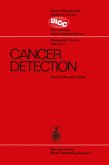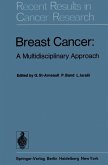Lymphoid Neoplasias I
Classification Categorization Natural History
Herausgegeben von Mathe, G.; Seligmann, M.; Tubiana, M.
Lymphoid Neoplasias I
Classification Categorization Natural History
Herausgegeben von Mathe, G.; Seligmann, M.; Tubiana, M.
- Broschiertes Buch
- Merkliste
- Auf die Merkliste
- Bewerten Bewerten
- Teilen
- Produkt teilen
- Produkterinnerung
- Produkterinnerung
CNRS International Colloquium, Held in Paris on June 22-24, 1977
Andere Kunden interessierten sich auch für
![Lymphoid Neoplasias II Lymphoid Neoplasias II]() Lymphoid Neoplasias II81,99 €
Lymphoid Neoplasias II81,99 €![Fundamentals of Cancer Prevention Fundamentals of Cancer Prevention]() Fundamentals of Cancer Prevention120,99 €
Fundamentals of Cancer Prevention120,99 €![Mechanisms of Invasion in Cancer Mechanisms of Invasion in Cancer]() Mechanisms of Invasion in Cancer81,99 €
Mechanisms of Invasion in Cancer81,99 €![Cancer Detection Cancer Detection]() Cancer Detection81,99 €
Cancer Detection81,99 €![The MASCC Textbook of Cancer Supportive Care and Survivorship The MASCC Textbook of Cancer Supportive Care and Survivorship]() The MASCC Textbook of Cancer Supportive Care and Survivorship120,99 €
The MASCC Textbook of Cancer Supportive Care and Survivorship120,99 €![Breast Cancer Breast Cancer]() Breast Cancer81,99 €
Breast Cancer81,99 €![Women at High Risk to Breast Cancer Women at High Risk to Breast Cancer]() Women at High Risk to Breast Cancer41,99 €
Women at High Risk to Breast Cancer41,99 €-
-
-
CNRS International Colloquium, Held in Paris on June 22-24, 1977
Hinweis: Dieser Artikel kann nur an eine deutsche Lieferadresse ausgeliefert werden.
Hinweis: Dieser Artikel kann nur an eine deutsche Lieferadresse ausgeliefert werden.
Produktdetails
- Produktdetails
- Recent Results in Cancer Research .64
- Verlag: Springer / Springer Berlin Heidelberg / Springer, Berlin
- Artikelnr. des Verlages: 978-3-642-81248-4
- Softcover reprint of the original 1st ed. 1978
- Seitenzahl: 356
- Erscheinungstermin: 15. Dezember 2011
- Englisch
- Abmessung: 244mm x 170mm x 20mm
- Gewicht: 615g
- ISBN-13: 9783642812484
- ISBN-10: 3642812481
- Artikelnr.: 36119346
- Herstellerkennzeichnung Die Herstellerinformationen sind derzeit nicht verfügbar.
- Recent Results in Cancer Research .64
- Verlag: Springer / Springer Berlin Heidelberg / Springer, Berlin
- Artikelnr. des Verlages: 978-3-642-81248-4
- Softcover reprint of the original 1st ed. 1978
- Seitenzahl: 356
- Erscheinungstermin: 15. Dezember 2011
- Englisch
- Abmessung: 244mm x 170mm x 20mm
- Gewicht: 615g
- ISBN-13: 9783642812484
- ISBN-10: 3642812481
- Artikelnr.: 36119346
- Herstellerkennzeichnung Die Herstellerinformationen sind derzeit nicht verfügbar.
I: Current Morphologic Categorizations.- Lymphomas We Must Classify.- Integration of Modern Data in WHO Categorization of Lymphosarcomas. Its Value for Prognosis Prediction and Therapeutic Adaptation to Prognosis.- Functional Classification of Malignant Lymphoma of Lukes and Collins.- Personal Points of View on the Kiel Classification.- Morphological Classification of Non-Hodgkin's Lymphomas.- Some Considerations on the Classification of the Lymphoid Neoplasias.- Current Techniques for the Study of Cell Morphology.- Classifications of the Malignant Lymphomas: A Survey.- Surface Morphology of Lymphoreticular Cells: Review of Data Obtained From Scanning Electron Microscopy.- Scanning Electron Microscopy Morphology of Mononuclear Leukocytes in Normal Subjects and in Patients With Lymphoid and Monocytoid Neoplasias.- Cytochemistry An Aid to the Diagnosis and Classification of the Acute Leukemias.- Dynamic Morphology of Human Lymphoid Leukemias.- Histiocytic and/or Reticulum Cell Neoplasias.- Conclusions of the First Session: Correlations Between Current Morphologic Categorizations.- II: Membrane Markers and Immunologic Categorization.- Human T-Derived Lymphoproliferative Diseases.- Immunologic Markers of Non-Hodgkin's Lymphomas.- Categorization of Non-Hodgkin's Hematosarcomas (Lymphomas) According to T- and B-Cell Markers: Its Value for Diagnosis and Prognosis.- Demonstration of Immunoglobulin Production by Tumor Cells in Non-Hodgkin's and Hodgkin's Malignant Lymphomas and Its Significance for Their Classification.- Immunoglobulin Production in Lymphoma Cells: An Immunoelectron Microscopy Study.- Biochemical Markers in Hodgkin's Disease and Non-Hodgkin's Lymphoma.- Biology of the Human Malignant Lymphomas.- Comparison Between Membrane Markers and EnzymeMarkers in 26 Cases of Non-Hodgkin's Malignant Lymphomas.- Hairy Cell Leukemia: B-Lymphocyte and Monocytic Properties Displayed by One Cell.- Facultative Phagocytosis by Leukemic B-Lymphocytes: Further Proof of the B-Cell Nature of Hairy Cells.- Hairy Cell Leukemia: Vascular Changes in Spleen and Liver.- Upon the Nature of Hodgkin's Disease and the Reed-Sternberg Cell.- III: Natural History of Lymphoid Neoplasias: Human and Experimental Models.- Evolution of Immunoblastic Lymphoma in Angioimmunoblastic Lymphadenopathy.- Immunoblastic Lymphadenopathy: A Prelymphomatous State of Immunoblastic Sarcoma.- Angioimmunoblastic Lymphadenopathy: Clinical, Biologic, and Follow-up Study of 14 Cases.- Hydantoin-Induced Lymphadenopathies and Lymphomas.- Hydantoin-Induced Lymphadenopathies and Lymphomas: Experimental Studies in Mice.- Natural History of ?-Chain Disease and the So-called Mediterranean Lymphoma.- Neoplastic Proliferation and Natural History of B-Cell Neoplasia.- Castleman's Disease.- Benign and Malignant Lymphoid Proliferation in Autoimmunity.- Lymphomagenesis and Autoimmunization Caused by Reactions of T-Lymphocytes to Incompatible Structures of the Major Histocompatibility Complex: A Concept of Pathogenesis.- Neoplasms of Immunoglobulin-Producing Cells in Mice.- From Experimental Animal Models to Human Lymphoid Tissue Neoplasia: Search for a Viral Etiology.
I: Current Morphologic Categorizations.- Lymphomas We Must Classify.- Integration of Modern Data in WHO Categorization of Lymphosarcomas. Its Value for Prognosis Prediction and Therapeutic Adaptation to Prognosis.- Functional Classification of Malignant Lymphoma of Lukes and Collins.- Personal Points of View on the Kiel Classification.- Morphological Classification of Non-Hodgkin's Lymphomas.- Some Considerations on the Classification of the Lymphoid Neoplasias.- Current Techniques for the Study of Cell Morphology.- Classifications of the Malignant Lymphomas: A Survey.- Surface Morphology of Lymphoreticular Cells: Review of Data Obtained From Scanning Electron Microscopy.- Scanning Electron Microscopy Morphology of Mononuclear Leukocytes in Normal Subjects and in Patients With Lymphoid and Monocytoid Neoplasias.- Cytochemistry An Aid to the Diagnosis and Classification of the Acute Leukemias.- Dynamic Morphology of Human Lymphoid Leukemias.- Histiocytic and/or Reticulum Cell Neoplasias.- Conclusions of the First Session: Correlations Between Current Morphologic Categorizations.- II: Membrane Markers and Immunologic Categorization.- Human T-Derived Lymphoproliferative Diseases.- Immunologic Markers of Non-Hodgkin's Lymphomas.- Categorization of Non-Hodgkin's Hematosarcomas (Lymphomas) According to T- and B-Cell Markers: Its Value for Diagnosis and Prognosis.- Demonstration of Immunoglobulin Production by Tumor Cells in Non-Hodgkin's and Hodgkin's Malignant Lymphomas and Its Significance for Their Classification.- Immunoglobulin Production in Lymphoma Cells: An Immunoelectron Microscopy Study.- Biochemical Markers in Hodgkin's Disease and Non-Hodgkin's Lymphoma.- Biology of the Human Malignant Lymphomas.- Comparison Between Membrane Markers and EnzymeMarkers in 26 Cases of Non-Hodgkin's Malignant Lymphomas.- Hairy Cell Leukemia: B-Lymphocyte and Monocytic Properties Displayed by One Cell.- Facultative Phagocytosis by Leukemic B-Lymphocytes: Further Proof of the B-Cell Nature of Hairy Cells.- Hairy Cell Leukemia: Vascular Changes in Spleen and Liver.- Upon the Nature of Hodgkin's Disease and the Reed-Sternberg Cell.- III: Natural History of Lymphoid Neoplasias: Human and Experimental Models.- Evolution of Immunoblastic Lymphoma in Angioimmunoblastic Lymphadenopathy.- Immunoblastic Lymphadenopathy: A Prelymphomatous State of Immunoblastic Sarcoma.- Angioimmunoblastic Lymphadenopathy: Clinical, Biologic, and Follow-up Study of 14 Cases.- Hydantoin-Induced Lymphadenopathies and Lymphomas.- Hydantoin-Induced Lymphadenopathies and Lymphomas: Experimental Studies in Mice.- Natural History of ?-Chain Disease and the So-called Mediterranean Lymphoma.- Neoplastic Proliferation and Natural History of B-Cell Neoplasia.- Castleman's Disease.- Benign and Malignant Lymphoid Proliferation in Autoimmunity.- Lymphomagenesis and Autoimmunization Caused by Reactions of T-Lymphocytes to Incompatible Structures of the Major Histocompatibility Complex: A Concept of Pathogenesis.- Neoplasms of Immunoglobulin-Producing Cells in Mice.- From Experimental Animal Models to Human Lymphoid Tissue Neoplasia: Search for a Viral Etiology.








